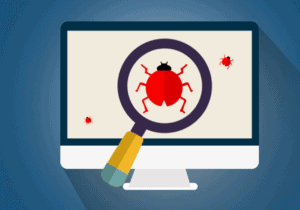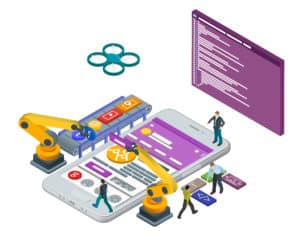You’ve validated, designed and developed your app. Kudos! Launch time?
Not Yet.
According to a study,
“The top reason why people deleted apps after installing was because of crashes or installation errors. This figure amounted to around 62%.”
Therefore, carrying out a full-proof quality assurance protocol for your mobile app is almost as important as validating your idea. We’ve therefore put together this comprehensive guide to discuss the procedure, tools and best practices involved in mobile app QA to ensure you’re building for success.
Table of Contents
- What is quality assurance?
- Difference between quality assurance and quality control
- Difference between software quality assurance and software testing
- Importance of quality assurance
- Software Testing Strategies
- Top 4 software testing tools for QA
- Quality assurance process at Topflight Apps
- Quality assurance methods and best practices
What is Quality Assurance?
Quality assurance (QA) is the effort a company takes to ensure that it provides the best possible product and experience to the end-user. At the end of the day, as a mobile application provider, you want to ensure that everything works as intended, at the speed it should be working at, and on the device the user is on.

QA is vital because according to studies, people delete apps after crashes or encounter installation errors 48% of the time. People have a low tolerance for bad mobile applications and, in essence, a flawed QA process. It also means you’re eliminating any potential viral factor for your mobile app spreading and severely reducing your organic traffic.
This risk is why you need to create proactive QA strategies to tackle functionality, usability, performance, security, and cross-platform issues.
Difference Between Quality Assurance and Quality Control
Quality control (QC) differs from quality assurance (QA) by selling out processes to produce a quality software product. The primary purpose of QC is to ensure that the software product meets the requirements as intended. The client will provide you with a detailed requirements document, and quality control delivers according to specifications. Essentially, remember when talking quality assurance vs quality control, the latter is a reactive measure to ensure proper delivery and a happy customer.

Just a note, a customer can differ from the end-user. The end-user will be the person finally using the mobile app. That means for us here at Topflight Apps, we build for two audiences simultaneously. We want to have a satisfied customer and user.
While quality assurance is aimed to prevent defects, quality control aims to identify and fix defects throughout the mobile application’s entire life cycle while delivering per specifications.
There is more documentation in a QA step over a QC step. There is more consideration into setting up your architecture to ensure quality by following software development patterns to reduce issues.
The importance differentiator between QA vs QC is that QA is a proactive measure to ensure quality, while again, QC is a reactive step, which also means QA is performed before QC. You want to continually ensure your software is consistent with your standards as you develop. Hence, you want to be testing your mobile application to avoid costly bugs and increase app development costs down the road.
Difference Between Software Quality Assurance and Software Testing
Software QA differs from software testing by the process it sets in mobile QA testing. When it comes to QA vs software testing, it is about an engineering process that ensures quality versus merely testing the product for problems.

A QA step is more process-focused instead of product-focused. Quality assurance is more about preventative techniques instead of corrective actions.
There can be a difference in testing tools for QA versus software testing tools, which may require you to use both to ensure the highest quality for your mobile product.
Related Article: How to Build Efficient Automated Testing Strategy
Importance of Mobile App Quality Assurance
Mobile applications often lack the power that a personal computer or laptop have, so specific tests must be administered to ensure proper performance. A desktop experience differs drastically from a mobile experience, often due to a mobile device’s limited resources compared to a desktop or laptop computer.
Mobile devices have screens that vary in their sizes, extensions, and color profiles. These variations mean you have to build and test across multiple devices. While there are great tools that help automate this, it is still an important step to plan your mobile app testing process and invest in these mobile testing tools.

The other thing that people tend to forget is that a good QA process reduces your project’s overall cost. A robust quality assurance program ultimately ensures a lower maintenance cost throughout the product lifecycle. This cost reduction is because you’re continually finding issues instead of letting them pile up at the end, possibly costing you customers.
App QA Testing Strategies
It is important to go over Quality Assurance testing strategies because how you approach it is just as important as how you do it. It is often advisable to implement multiple testing approaches because of all of the software dimensions ranging from differing platforms, hosting, user interface libraries, performances, and security vulnerabilities.

It also requires testing under various stress levels because a custom developed mobile application that performs under 5 concurrent users vs. 500 concurrent users can be vastly different. A good strategy is to implement automated mobile application testing to help identify new bugs, especially when launching new features.
Here is a list of tests you can perform to help you:
Functional Testing
Mobile functionality testing typically looks to ensure that the application works as the initial requirements. It first considers the industry and services that the mobile app is built for, and once that is identified, it considers a distribution channel as well.
It looks to provide each function with the necessary input, verify the output, and then compare the results with initial requirements. It is to ensure faultless functionality, and this is vital to any mobile application.
Regression Testing
Regression testing is essential in mobile app QA testing to ensure the initial code doesn’t crash weeks/months later because of optimization, refactoring, or the implementation of new software features.
Often, small code modifications can break unrelated features unexpectedly. For example, you could implement a geolocation feature that breaks your authorization module for no apparent reason. This sort of effect explains why regression testing is necessary and should be performed on more than just a couple of essential functionalities.
A good regression strategy model can integrate several automated tests. These can be:
- Multiple platform automation
- Risk-based regression
- Parallel execution to save time
- Performance impact analysis
- Continuous testing QA methodologies
Regression testing for mobile applications occurs after a release to identify issues such as bugs and glitches.
Cross-Platform Testing
As we all know, there are two major operating systems for mobile devices, android, and iOS, which means that you have to be testing across platforms and devices. Each platform can have different features and functionalities, so you have to be testing to see how your app gets rendered, how the user interface looks, and how the app performs overall.

Usability Testing
Usability testing is where you have users play with your application to determine how easy it is to use the apps in their face. App performance, easy to read icons and text to allow them to browse your application intuitively. This sort of testing can also be an opportunity to uncover any glitches.
One way to quickly solve the usability testing issue before you even code is by building mock-ups and prototypes you share with existing or potential users. Here are some great strategies for using Figma for prototyping and mock-ups.
Performance Testing
This is another important stage in the mobile QA process workflow for your application. Many factors can affect an app’s performance, such as the concurrent users that load an app on a device, specifically the battery or ram. Performance QA testing is critical to consider because you don’t want to be known as the app that drains battery or slows down everything else.
Security Testing
Having a fully functional app can be great; having an app that lacks proper security can lead to unintended consequences. This security risk means you may have to test for proper authentication and secure storage of private data. If you’re building a healthcare application, you will need to test your data’s encryption and ensure the connection to your HIPAA-complaint app is secure and not accessible by any non-whitelisted IP addresses.
It also means that you’re only authorizing the correct users and allowing them to access only their information. This step will determine how and where you stored information and what web services you use. It will help you assess your database structure for your multi-tenancy mobile applications.
Top 4 Testing Tools for App QA
As you look to add software testing tools to ensure a more rigorous quality assurance plan, you’ll want to look at some of the tools provided below. Before you look at the tools, outline what you’re currently looking to monitor, what you’re looking to fix, and the type of reporting you’re looking at receiving. Each tool has its strengths and weaknesses, and specialities. Here is a good list of tools to start off with:
Sentry
Sentry is excellent at letting you democratize critical data out of silos and trace issues through the entire architecture, from your API down to your server. This tool helps increase performance and find bottlenecks by aggregating crash and error reporting. There can be bugs impacting 100,000 people, while other bugs only affect 1,000. This way, you can target the influential bugs first. It offers both iOS and Android crash reporting and React Native support.
Crashlytics
Crashlytics is under the Google ecosystem. It is a great tool that is a lightweight, real-time crash reporting tool that will help you determine what caused the crash. While helping you pinpoint the root cause of crashes, it can also prioritize what to fix first by user impact reports.
Crashlytics offers a deep integration with Google Analytics, which is one of the benefits of being a trusted Google product. It is used by companies such as Gameloft, Pomelo Games, and Tapps Games.
New Relic
New Relic is a tool for web application performance services built to track everything in real-time with your web application or mobile application. It is built for full-stack observability, which can track distributed services, applications, and serverless functions.
New Relic’s infrastructure provides flexibility and allows you to make decisions about your system through the robust data profiles it provides. Often it is called a performance dashboard with x-ray vision because it will enable you to instantly detect, diagnose, and resolve issues before customers notice.
It is trusted by companies such as Heart, American Eagle, H&R Block, and ABInBev.
Kobiton
Kobiton is great at allowing you to do real device testing in both a manual and automated fashion. This allows you from your desktop to test natural mobile gestures which include tap, swipe, and scroll. It captures detailed video logs, screenshots, and indications of which gestures were performed, while also showing you the statistics of how memory and battery usage were.
Quality Assurance Process at TopflightApps
At Topflight, development services are always complemented by app quality assurance services to ensure that we deliver top-notch results. These services can be scaled according to each client’s specific needs.

Basic QA
Basic QA is a required companion to any development work, and is comprised of two main blocks:
Unit testing
Performed by each developer, who is checking that the body of code that they are committing to the project, meets the acceptance criteria.
Integration testing
Performed by our QA department, who are checking that multiple units, potentially committed by multiple developers, meet holistic acceptance criteria when deployed in their totality. Our experience across hundreds of projects allows us to estimate Basic QA hours relative to the scoped development work, based on project typology.
Usability testing
As mentioned above, usability testing is a method of testing the functionality of a website, app, or other digital product by observing real users as they attempt to complete tasks on it. The goal is to reveal areas of confusion and uncover opportunities to improve the overall user experience.
We utilize usertesting.com for their services between the design and development stages to get feedback about the idea and design to make sure it meets expectations for the target audience before we begin development.
Automated cross-device testing
In addition to the informal testing performed in basic QA, we also offer formalized and automated testing, based on BrowserStack service. The platform enables automated testing across more than 2,000 real mobile devices and browsers. Costs are established on a project basis, by jointly deciding on:
- The features we want to test
- The set of devices we want to test against
- Frequency and duration of testing
Full test reports listing features, releases, devices, OS and browser versions tested against are made available as regular deliverables, or by sharing an account on our test tracking tool with you.
Regression testing
Performed by our QA department, who are checking each test build against a predefined set of test cases, to verify that all previous developed and tested functionalities of an application continue to work after bug fixes, new features, etc are included in the new build on different mobile devices/desktop browsers.
IoT testing
Performed by our developers and QA team. This typically requires a provided device, and we also have the ability to create “fake device” builds to replicate functionality on the app under development.
Quality Assurance Best Practices and Methodologies
Here are a few QA best practices and methods to ensure you’re making the most of your process:
- Set a Release Criteria
- Implement automated testing integrations
- Allocate appropriate time for each process
- Prioritize bug fixes based on feature usage
- Carve out time for QA
- Include estimates for QA in budgets
- Don’t leave QA for the end of the development process
- Make QA a continuous process in the lifecycle of a mobile application

At the end of the day, if you plan and budget for a quality assurance process, you will set yourself up for success. The importance of this means not cutting it out of your budget but making sure it is in there. It also means separating it from your quality control step and having it as a separate consideration.
There are some great tools out there to help you automate parts of the process but they will still require diligent setups. You have to know what you want to be testing and assuring quality on.
Related Articles:
- Agile App Development Guide
- A Guide to Redesigning a Mobile App
- How long does it take to develop a mobile app
- Building the perfect mobile app is a journey not a sprint
Frequently Asked Questions
What software testing tool should I use?
The tool you use depends on your setup, your tech stack, and the level of commitment your team will provide.
Does Quality Assurance prevent all bugs?
Even with a good QA program, you can’t eliminate all bugs. Bugs are inevitable. A good QA program helps reduce them, and avoid costly mistakes.
If I have quality control, why do I need quality assurance?
Quality assurance prevents problems, while quality controls helps make sure you deliver according to your specifications.
How should we set up a quality assurance program?
You should set a good QA program as soon as you can. It should be included into your estimates and your budgets.
